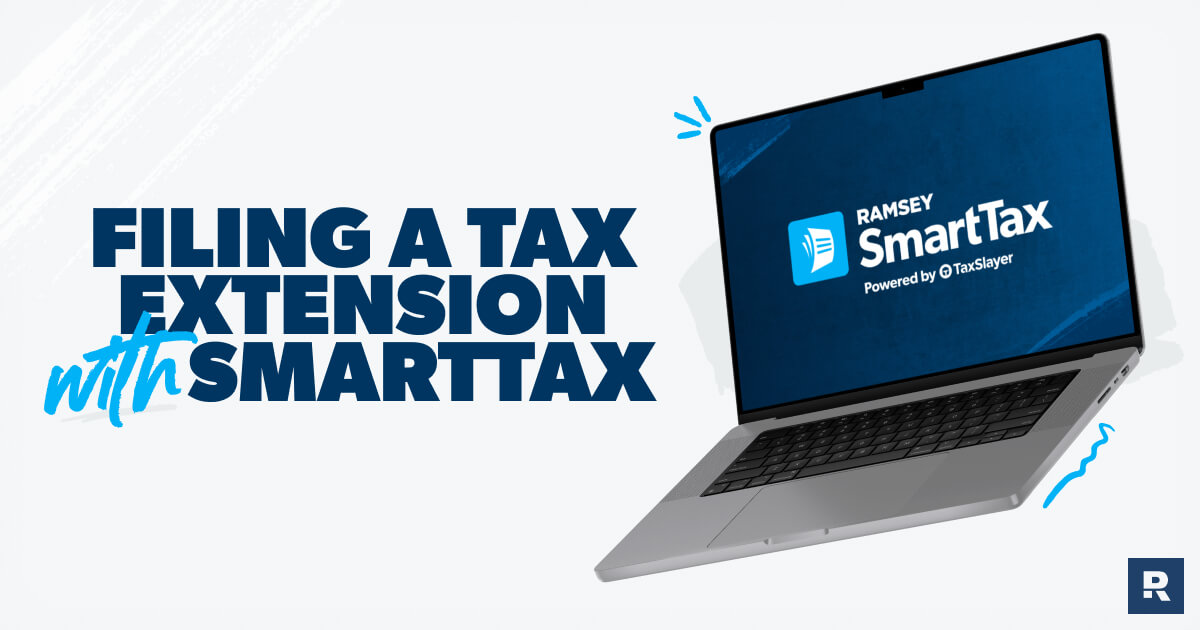
Key Takeaways
- If you can’t file your tax return by the tax filing deadline, the IRS allows you to request an extension that postpones your deadline to file by six months.
- Ramsey SmartTax makes it easy to file for a tax extension in five simple steps using Form 4868, Application for Automatic Extension of Time to File.
- Filing a tax extension only gives you more time to file your tax return. If you have a tax bill, you still need to pay the IRS what you owe in taxes by the original tax filing deadline (usually April 15).
Take a second and imagine yourself taking a nice, long walk at your favorite park on a lovely spring day in April. The sun is shining, the birds are singing, the flowers are blooming . . . everything is perfect.
And then it hits you. It’s not just any day in April. It’s April 15. It’s Tax Day. And you haven’t filed your tax return yet. Just like that, your peaceful walk in the park is cut short as you run to your car and rush home to do your taxes before the clock strikes midnight.
But before you go into full-on panic mode, remember that the IRS allows taxpayers to file for a tax extension that postpones your deadline to file by six months.
So, if you’re out of the country, missing a tax form, or dealing with incorrect information on a form you received—or if Tax Day just snuck up on you (we’ve all been there)—a tax extension can give you some much-needed breathing room. And it can help you avoid late-filing penalties and interest.
Filing a Tax Extension With Ramsey SmartTax
If you’re filing your tax return with our easy-to-use tax software Ramsey SmartTax, we make it super easy to file a tax extension so you can relax, get everything in order, and file when you’re ready.
It’s important to remember, though, that a tax extension pushes back your deadline to file but not your deadline to pay whatever taxes you owe. That’s right—the IRS still expects you to pay your tax bill by Tax Day (which usually falls on April 15). If you don’t pay your tax bill on time, you’ll face penalties and additional interest on the unpaid amount.
What if you’re owed a tax refund? Good news! You won’t be charged a failure-to-file or failure-to-pay penalty because those penalties only apply if you owe taxes. But you need to keep these three things in mind:
- First, you might not know if you’ll get a tax bill or get a tax refund until you file your return. Additional sources of income or changes to your tax situation might lead to a “tax surprise” if you’re not on top of things.
- Second, you might live in a state that charges a late-filing penalty even if you’re owed a refund. For example, Wisconsin charges a flat $50 late-filing fee if you miss the deadline—refund or not.1
- And finally, you won’t get your refund until you file your tax return. The longer you put off filing your tax return, the longer you’ll have to wait to get back the money that’s rightfully yours.
So, even if you do expect to get a refund this year, it still might be a good idea to file a tax extension. Don’t worry—Ramsey SmartTax makes it easy!
Here’s how to file a tax extension (for free!) with Ramsey SmartTax in five simple steps.
1. Create an account or log in to Ramsey SmartTax.
If you haven’t created an account with Ramsey SmartTax, what are you waiting for? You can create an account and get your tax extension in just a few minutes.
Don’t settle for tax software with hidden fees or agendas. Use one that’s on your side—Ramsey SmartTax.
Already have an account? Welcome back! Simply log in with your username and password and get started. Hurry—there’s no time to waste!
2. Fill out your personal information.
Once you’re logged in and ready to get started, Ramsey SmartTax will ask you to fill out personal information for yourself, your spouse (if you’re filing jointly), and any qualifying dependents you’re claiming on your tax return this year.
When that’s done, you’re ready to get on with your tax extension.
3. Find the tax form for filing a tax extension (Form 4868).
Form 4868 is the tax form you’ll use to apply for an automatic extension of time to file your individual income tax return (how many tax forms does the IRS have, anyway?).2
Here’s how to find the form on Ramsey SmartTax:
- Select Federal on the main menu.
- Then select Miscellaneous Forms.
- Finally, select Application for Automatic Extension of Time to File (Form 4868).
4. Fill out the application for a tax extension.
We’ve already said this once, but it’s worth saying it again so you don’t forget: Filing a tax extension gives you an additional six months to file your return but not extra time to pay your tax bill (if you have one).
That’s why, once you get to the Form 4868 page on Ramsey SmartTax, you’ll have an opportunity to pay your tax bill when you submit your tax extension request. Here’s the information you’ll be asked to provide on your extension request form:
- Estimated tax liability: This is an estimate of the total amount of taxes you owe to the federal government. Make your estimate as accurate as you can with the information you have. If the IRS takes a look and says the estimate wasn’t reasonable, your extension may get rejected later. (But don’t stress out—we can help you figure out how much you owe in taxes for the year.)
- Amount previously paid for current tax year: This is the total amount of any taxes you’ve already paid throughout the tax year, including quarterly estimated payments and tax withholding.
- Amount paid with extension: This is the amount you’re going to pay to the IRS when you file your tax extension request.
Once you’ve filled out that information, you can select Go to Extension Payment near the bottom of the page and enter your payment information. You can pay your income taxes directly from your bank account with electronic withdrawal or by mailing a check to the IRS.
5. File your tax extension electronically.
After you’ve completed Form 4868, you’re ready to file it electronically with Ramsey SmartTax, just like you would with a regular tax return. And that’s it—you’re done!
Keep in mind that you need to file your tax extension by the due date of your tax return. For 2024 tax returns, the deadline is April 15, 2025, for most taxpayers.3
Next Steps
- If you usually wait until the very last minute to file your taxes, you’re not alone. To help you make tax season less stressful, here are some helpful tax tips for all you procrastinators out there.
- Dealing with a complicated tax situation? You don’t have to face it on your own. Get in touch with a RamseyTrusted® tax pro who can give you expert advice and take the stress out of tax season.
- If you’re confident you can handle your taxes on your own and ready to file your return (or maybe a tax extension) today, head on over to Ramsey SmartTax.
Federal Classic Includes:
-
All major income types and federal forms
-
Prepare, print and e-file
-
Phone and email support
-
1 year of audit assistance
Federal Premium Includes:
Everything in Federal Classic plus:
-
Live chat
-
Priority phone and email help
-
Free financial coaching session
-
3 years of audit assistance
-
1 month of ID theft protection
Frequently Asked Questions
-
What if I live in a state impacted by a natural disaster? Do I still need to file a tax extension?
-
If you live somewhere affected by a natural disaster—like a hurricane, wildfire or earthquake—the IRS usually provides relief to taxpayers in these areas by postponing various tax filing and payment deadlines, so you might not need to file a tax extension.
But keep in mind that not everyone living in these states automatically qualifies for the extended tax filing deadline. The IRS only grants extensions to individuals and businesses in federally designated disaster areas, usually specific counties identified by the Federal Emergency Management Agency (FEMA).
For 2025, the IRS extended deadlines for some taxpayers in several states that were affected by natural disasters:
- May 1, 2025: Taxpayers in the entire states of Alabama, Florida, Georgia, North Carolina and South Carolina; and taxpayers in certain cities and counties in Alaska, New Mexico, Tennessee and Virginia.
- Oct. 15, 2025: Victims of the Los Angeles wildfires have until Oct. 15, 2025, to file returns and pay any taxes due during that period.
- Nov. 3, 2025: All of Kentucky and several counties in West Virginia have their tax filing deadline extended to Nov. 3, 2025.4
Make sure you check with your state’s government and keep up with IRS announcements for any updates on disaster-related extensions for your area. If you’re still not able to file your tax return by these new deadlines, you should file a tax extension with the IRS.
-
What’s the penalty for not filing my taxes on time?
-
If you don’t file your taxes on time and don’t file a tax extension, you’ll be charged a failure-to-file penalty. That means you’ll have to pay late fees and interest starting at 5% of your unpaid tax bill every month, up to a max of 25%.5
-
What’s the penalty for not paying my taxes on time?
-
If you don’t pay your full tax bill by the tax filing deadline (regardless of whether or not you filed a tax extension), you’ll be looking at a failure-to-pay penalty. This penalty is smaller than the failure-to-file penalty, starting at only 0.5% of your unpaid tax bill each month (also capped at 25% max).6




